Choosing a Gaming CPU October 2013: i7-4960X, i5-4670K, Nehalem and Intel Update
by Ian Cutress on October 3, 2013 10:05 AM ESTFor an article like this getting a range of CPUs, which includes the most common and popular, is very important. I have been at AnandTech for just over two years now, and in that time we have had Sandy Bridge, Llano, Bulldozer, Sandy Bridge-E, Ivy Bridge, Trinity and Vishera, of which I tend to get supplied the top end processors of each generation for testing (as a motherboard reviewer, it is important to make the motherboard the limiting factor). A lot of users have jumped to one of these platforms, although a large number are still on Wolfdale (Core2), Nehalem, Westmere, Phenom II (Thuban/Zosma/Deneb) or Athlon II. I have attempted to pool all my AnandTech resources, contacts, and personal resources, together to get a good spread of the current ecosystem, with more focus on the modern end of the spectrum. It is worth nothing that a multi-GPU user is more likely to have the top line Ivy Bridge, Vishera or Sandy Bridge-E CPU, as well as a top range motherboard, rather than an old Wolfdale. As time progresses I hope to obtain greater ranges of CPU speeds, core counts, and caches to suit almost all tastes.
The CPUs
My criteria for obtaining CPUs was to use at least one from the most recent architectures, as well as a range of cores/modules/threads/speeds. The basic list as it stands is shown below, with the CPU.GPU on the left showing what we were able to test:
| VIA | |||||||||
| CPU | GPU | Name | IGP | Socket | C / M (T) | Speed | Turbo | L2/L3 | |
|---|---|---|---|---|---|---|---|---|---|
| L2007 | Nano | BGA400 | 1 (1) | 1600 | 1 MB / - | ||||
| AMD | |||||||||
| CPU | GPU | Name | IGP | Socket | C / M (T) | Speed | Turbo | L2/L3 | |
| E-350 | Fusion | FT1 | 2 (2) | 1600 | 1 MB / - | ||||
| A6-3650 | Llano | FM1 | 4 (4) | 2600 | 4 MB / - | ||||
| A8-3850 | Llano | FM1 | 4 (4) | 2900 | 4 MB / - | ||||
| A8-5600K | Trinity | FM2 | 2 (4) | 3600 | 3900 | 4 MB / - | |||
| A10-5800K | Trinity | FM2 | 2 (4) | 3800 | 4200 | 4 MB / - | |||
| A6-5200 | Kabini | FT3 | 4 (4) | 2000 | 2 MB / - | ||||
|
Phenom II X2-555 BE |
Callisto K10 | AM3 | 2 (2) | 3200 | 1 MB / 6 MB | ||||
|
Phenom II X4-960T |
Zosma K10 | AM3 | 4 (4) | 3200 | 2 MB / 6 MB | ||||
|
Phenom II X6-1100T |
Thuban K10 | AM3 | 6 (6) | 3300 | 3700 | 3 MB / 6 MB | |||
| FX-8150 | Bulldozer | AM3+ | 4 (8) | 3600 | 4200 | 8 MB / 8 MB | |||
| FX-8350 | Piledriver | AM3+ | 4 (8) | 4000 | 4200 | 8 MB / 8 MB | |||
| Intel | |||||||||
| CPU | GPU | Name | IGP | Socket | C / M (T) | Speed | Turbo | L2/L3 | |
| E6400 | Conroe | 775 | 2 (2) | 2133 | 2 MB / - | ||||
| E6550 | Conroe | 775 | 2 (2) | 2333 | 4 MB / - | ||||
| E6700 | Conroe | 775 | 2 (2) | 2667 | 4 MB / - | ||||
| Q9400 | Yorkfield | 775 | 4 (4) | 2667 | 6 MB / - | ||||
|
Core i7-920 |
Nehalem | 1366 | 4 (8) | 2667 | 2933 | 1 MB / 8 MB | |||
|
Core i7-950 |
Nehalem | 1366 | 4 (8) | 3067 | 3333 | 1 MB / 8 MB | |||
|
Core i7-990X |
Westmere | 1366 | 6 (12) | 3467 | 3733 | 1.5 MB / 12 MB | |||
|
Xeon X5690 |
Westmere | 1366 | 6 (12) | 3467 | 3733 | 1.5 MB / 12 MB | |||
|
2 x Xeon X5690 |
Westmere | 1366 | 12 (24) | 3467 | 3733 | 1.5 MB / 12 MB | |||
|
Celeron 847 |
Sandy Bridge ULV |
BGA1023 | 2 (2) | 1100 | 0.5 MB / 2 MB | ||||
|
Celeron G465 |
Sandy Bridge |
1155 | 1 (2) | 1900 | 0.25 MB / 1.5 MB | ||||
|
Core i5-2500K |
Sandy Bridge |
1155 | 4 (4) | 3300 | 3700 | 1 MB / 6 MB | |||
|
Core i7-2600K |
Sandy Bridge |
1155 | 4 (8) | 3400 | 3800 | 1 MB / 8 MB | |||
|
Core i7-3930K |
Sandy Bridge-E |
2011 | 6 (12) | 3200 | 3800 | 1.5 MB / 12 MB | |||
|
Core i7-3960X |
Sandy Bridge-E |
2011 | 6 (12) | 3300 | 3900 | 1.5 MB / 15 MB | |||
|
2 x Xeon E5-2690 |
Sandy Bridge-EP |
2011 | 16 (32) | 2900 | 3800 | 2 MB / 20 MB | |||
|
4 x Xeon E5-4650L |
Sandy Bridge-EP |
2011 | 32 (64) | 2600 | 3100 | 2 MB / 20 MB | |||
|
Core i3-3225 |
Ivy Bridge | 1155 | 2 (4) | 3300 | 0.5 MB / 3 MB | ||||
|
Core i7-3770K |
Ivy Bridge | 1155 | 4 (8) | 3500 | 3900 | 1 MB / 8 MB | |||
|
Core i7-4960X |
Ivy Bridge-E | 2011 | 6 (12) | 3600 | 4000 | 1.5 MB / 15 MB | |||
|
Core i5-4430 |
Haswell | 1150 | 4 (4) | 3000 | 3200 | 1 MB / 6 MB | |||
|
Core i5-4670K |
Haswell | 1150 | 4 (4) | 3400 | 3800 | 1 MB / 6 MB | |||
|
Core i7-4770K |
Haswell | 1150 | 4 (8) | 3500 | 3900 | 1 MB / 8 MB | |||
|
Core i7-4750HQ |
Haswell + Crystalwell |
BGA1364 | 4 (8) | 2000 | 3200 |
1 MB / 6 MB 128 MB L4 |
|||
|
Xeon E3-1280 V3 |
Haswell | 1150 | 4 (8) | 3600 | 4000 | 1 MB / 8 MB | |||
|
Xeon E3-1285 V3 |
Haswell | 1150 | 4 (8) | 3600 | 4000 | 1 MB / 8 MB | |||
Note: the indication on the left hand side is whether we have tested the CPU in terms of our CPU tests or our GPU tests. In certain circumstances GPU tests were unavailable, but the CPU tests provide interesting data points.
This is Part 2 of our Gaming CPU series, with Part 1 covering a basic range of CPUs and a Haswell update covering the i7-4770K. For Part 2 this is primarily an Intel 4670K/Nehalem update, whereas Part 3 of our testing will focus on the AMD side. I currently have many AMD CPUs in house (Richland, Trinity, K10) and am on the request list for a few more (Vishera, more Richland).
The GPUs
My first and foremost thanks go to both ASUS and ECS for supplying me with these GPUs for my test beds. They have been in and out of 60+ motherboards without any issue, and will hopefully continue. My usual scenario for updating GPUs is to flip AMD/NVIDIA every couple of generations – last time it was HD5850 to HD7970, and as such in the future we will move to a 7-series NVIDIA card or a set of Titans (which might outlive a generation or two).
The ASUS HD 7970 we use is the reference model at the 7970 launch, using GCN architecture, 2048 SPs at 925 MHz with 3 GB of 4.6 GHz GDDR5 memory. We had four cards to be used in 1x, 2x, 3x and 4x configurations where possible, also using PCIe 3.0 when enabled by default, although for this update we were limited to three.
ECS GTX 580 (NGTX580-1536PI-F)
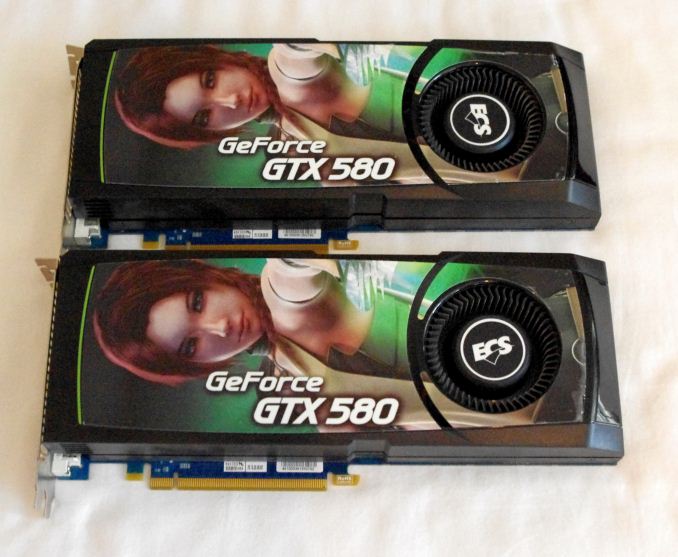
ECS is both a motherboard manufacturer and an NVIDIA card manufacturer, and while most of their VGA models are sold outside of the US, some do make it onto e-e-tailers like Newegg. This GTX 580 is also a reference model, with 512 CUDA cores at 772 MHz and 1.5 GB of 4 GHz GDDR5 memory. We have two cards to be used in 1x and 2x configurations at PCIe 2.0.
The Motherboards
The CPU is not always the main part of the picture for this sort of review – the motherboard is equally important as the motherboard dictates how the CPU and the GPU communicates with each other, and what the lane allocation will be. As mentioned on the previous page, there are 20+ PCIe configurations for Z87/Z77 alone when you consider some boards are native, some use a PLX 8747 chip, others use two PLX 8747 chips, and about half of the Z87/Z77 motherboards on the market enable four PCIe 2.0 lanes from the chipset for CrossFireX use (at high latency). We have tried to be fair and take motherboards that may have a small premium but are equipped to deal with the job. As a result, some motherboards may also use MultiCore Turbo, which as we have detailed in the past, gives the top turbo speed of the CPU regardless of the loading.
As a result of this lane allocation business, each value in our review will be attributed to both a CPU, whether it uses MCT, and a lane allocation.
| Motherboards | |||
|---|---|---|---|
| Socket | Chipset | Motherboard | PCIe |
| 1150 | Z87 |
ASUS Z87-Pro  |
PCIe 3.0 x8/x8 + PCIe 2.0 x4 |
MSI Z87-GD65 Gaming  |
PCIe 3.0 x8/x8/x4 | ||
GIGABYTE Z87X-UD3H  |
PCIe 3.0 x8/x8 + PCIe 2.0 x4 | ||
MSI Z87 XPower  |
PCIe 3.0 x8/x8/x8/x8 via PLX8747 | ||
| 1155 | Z77 |
ASUS Maximus V Formula  |
PCIe 3.0 x8/x4/x4 |
GIGABYTE Z77X-UP7  |
PCIe 3.0 x8/x8/x8/x8 via PLX8747 | ||
GIGABYTE G1.Sniper M3  |
PCIe 3.0 x8/x8 or x16 + PCIe 2.0 x4 | ||
| 2011 | X79 |
ASRock X79 Professional  |
PCIe 2.0 x16/x8/x8/x8 |
ASUS Rampage IV Extreme  |
PCIe 3.0 x16/x8/x8/x8 | ||
Gigabyte X79-UD3  |
PCIe 3.0 x16/x8/x8/x8 | ||
| 1366 | X58 |
GIGABYTE X58A-UD9  |
PCIe 2.0 x16/x16/x16/x16 via NF200 |
ASRock X58 Extreme3 .jpg ) |
PCIe 2.0 x16/x16 + x4 | ||
| 5520 |
EVGA SR-2  |
PCIe 2.0 x16/x16/x16/x16 via NF200 | |
| 775 | 975X |
MSI Platinum Power Up  |
PCIe 1.1 x8/x8 |
| P965 |
ASUS Commando  |
PCIe 1.1 x16 + x4 | |
| FM1 | A75 |
GIGABYTE A75-UD4H  |
PCIe 2.0 x8/x8 |
ASRock A75 Extreme6  |
PCIe 2.0 x8/x8 + x4 | ||
| FM2 | A85X |
GIGABYTE F2A85X-UP4  |
PCIe 2.0 x8/x8 + x4 |
| AM3 | 990FX |
ASUS Crosshair V Formula  |
PCIe 2.0 x16/x8/x8 |
| BGA400 | VX900 |
ECS VX900-I  |
N/A |
| BGA1023 | NM70 |
ECS NM70-I2  |
N/A |
| FT3 | A6-5200 |
ASRock IMB-A180-H .jpg ) |
N/A |
The Memory
Our good friends at G.Skill are putting their best foot forward in supplying us with high end kits to test. The issue with the memory is more dependent on what the motherboard will support – in order to keep testing consistent, no overclocks were performed. This meant that boards and BIOSes limited to a certain DRAM multiplier were set at the maximum multiplier possible. In order to keep things fairer overall, the modules were adjusted for tighter timings. All of this is noted in our final setup lists.
Our main memory testing kit is our trusty G.Skill 4x4 GB DDR3-2400 9-11-11 1.65 V RipjawsX kit which has been part of our motherboard testing for over twelve months. For times when we had two systems being tested side by side, a G.Skill 4x4 GB DDR3-2400 10-12-12 1.65 V TridentX kit was also used.
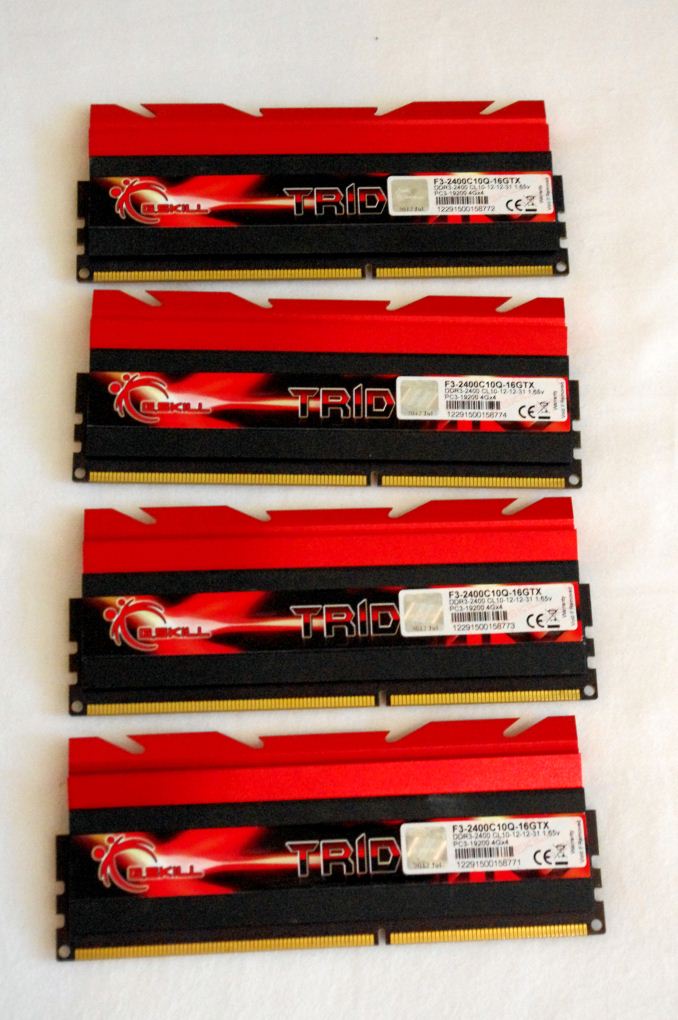
For The Beast, which is one of the systems that has the issue with higher memory dividers, we pulled in a pair of tri-channel kits from X58 testing. These are high-end kits as well, currently discontinued as they tended to stop working with too much voltage. We have a sets of 3x2 GB OCZ Blade DDR3-2133 8-9-8 and 3x1 GB Dominator GT DDR3-2000 7-8-7 for this purpose, which we ran at 1333 6-7-6 due to motherboard limitations at stock settings.
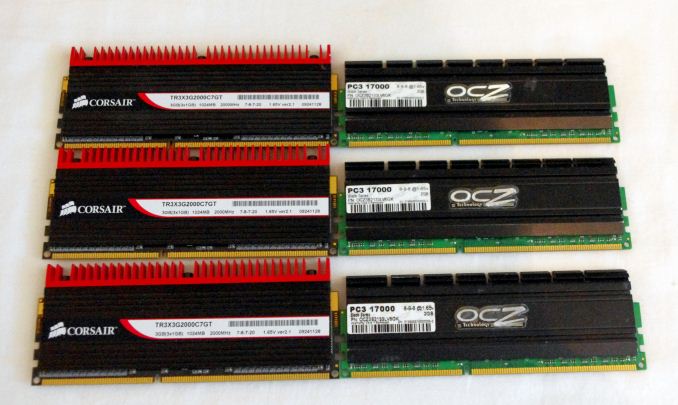
Our Core2Duo CPUs clearly gets their own DDR2 memory for completeness. This is a 2x2 GB kit of OCZ Platinum DDR2-666 5-5-5.
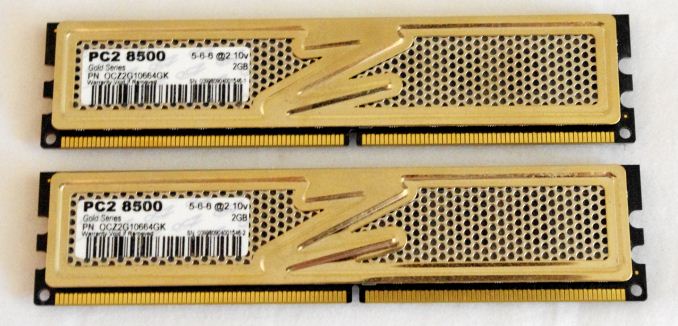
For Haswell we were offered new kits for testing, this time from Corsair and their Vengeance Pro series. This is a 2x8 GB kit of DDR3-2400 10-12-12 1.65 V.


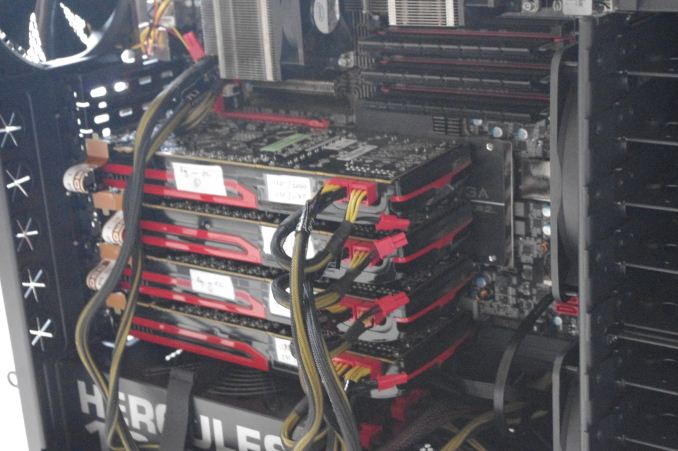
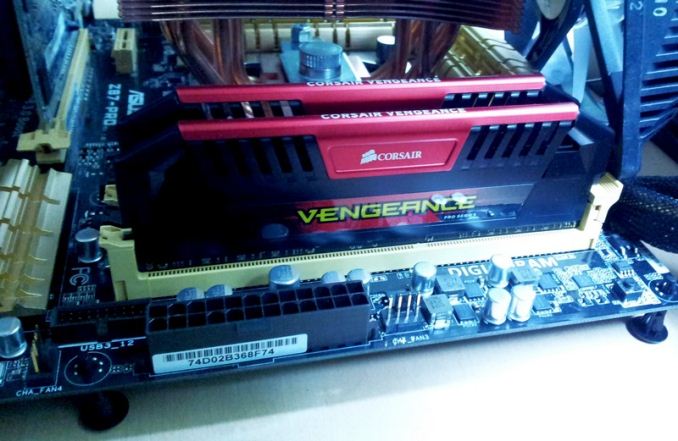








137 Comments
View All Comments
BOMBOVA - Saturday, October 26, 2013 - link
This article, prompted me to pull my P6T Asus mb out and replace it with a MSI 7666 which holds the 1366 I7 chip, i put in a 960 over my 920 , and clocked it up to 3.8x so far, and with my Nvidia 470 gpu, n raid 0 2x120 Gbyte ssd's things are rocking along, really good, it seems compared to the high end stuff presented here. , i had to install a cheap Syba controller card, on the Marvell chip set, set to 32 kbits, over 64 kbs, better data storage efficiency over speed, n a 4 channel usb 3.0 card, and it is good to go. , since i bought good , near new , used, i am in it for say half, price. and it works for me, i had a tough go, with microsoft critical patch updates. flooded on oct. 8th, n 15th. so my system restore points, crashed, , i am now set on NO automatic downloads, and all is good, " this is like a 3 day experience " i don't want to go through again, , enjoyed the article, and comments. good comments, thanks guys and girls. and am looking for the DD$4 stuff n Haswell super processor of 14, or early 15, now on to doing work with my computer :) , Cheers, all , have fun with candies, next, and have a good Xmas, buy yourselves something nice. lets keep america working, rtg. Vancouver CanadaWHISP - Tuesday, November 5, 2013 - link
Your review is talking about recommendations based on # of GPU's but seems to make the assumption GPU = graphics card. I have a GTX 690 and am looking to possibly upgrade my cpu/mobo, what would your recommendation be keeping in mind in the future I may buy another gtx690 to boost performance? What CPU PLX or non PLX combo do I need to satisfy two 690's in sli?Gastec - Tuesday, November 5, 2013 - link
You don't need PLX with dual-SLI, you don't even need a second GTX 690 :P I myself would never ever consider spending so much money on a video card, but I guess you play on multiple 30'' monitors with the maximum available resolution. Each with it's own. If you insist, then get the Intel i7-4960X, a socket 2011 X79 Asus motherboard with a PLX chip on it and 3 Nvidia GTX Titan. That would surely give you at least 150 FPS in any game except those that are specifically designed not to give more than what the designers want, like Crysis.Gastec - Tuesday, November 5, 2013 - link
I'm on a i7-860 since 2010 and HT was also a decision factor for buying it. But over the years I don't think HT has helped me that much with what I did and do on the PC. So now, after reading this article -which is very helpful- I think a i5-4670(K) with it's $100 lower price difference will suffice. Unless...upcoming games like The Elder Scrolls Online(that I want to play) will make use of HT, but I don't think so. Does anyone know of any game that makes good use of Hyper-Threading, or at least 4 cores?BlackOmega - Friday, November 8, 2013 - link
Goddammit. 6 years I spent without upgrading my rig, now I come back to anandtech and I can't understand one a single one of those benchmarks.Hell, WHERE ARE THE CPU CLOCK SPEEDS? How the hell Intel and AMD expect me to understand this gibberish the use to name their processors, I want to compare IPC on every bench I see, I want to see em every test how the ghz of one CPU compares to another. I'm not going to read those benchs with a cpu dictionary trying to interpret every name on this list, nor have I a good enough memory to remember what CPU have more cache ou clock speed than the other as described in the first page.
6 years I stood away from the hardware scene, now I came back and I can't understand anything.
/frustrated
BlackOmega - Friday, November 8, 2013 - link
ps: AMD and Intel naming scheme suck, give us back clock speed.oranos - Tuesday, November 26, 2013 - link
2500k best value gaming processor of all time :)